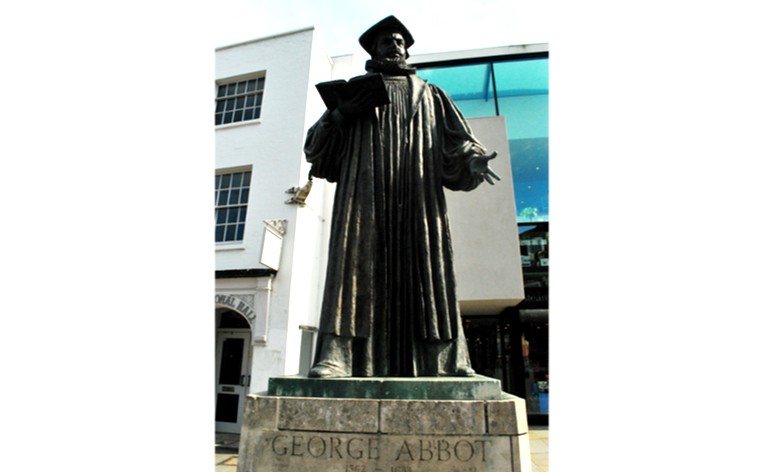George Abbot (19 October 1562-5 August 1633) was an English divine and Archbishop of Canterbury. Between 1612 and 1633, he also served as the fourth Chancellor of Trinity College, Dublin.
Born in Guildford, Surrey, Abbot was taught at The Royal Grammar School which is situated towards the top of Guildford High Street. He studied at Balliol College in Oxford where later he also taught and was chosen as Master of University College in 1597 and appointed Dean of Winchester in 1600. He attained the post of Vice-Chancellor of the University three times and took a leading role in the preparation of the authorised version of the New Testament. His efforts pleased King James VI, thusly resulting in him being made Bishop of Lichfield and Coventry in 1609.
He was then raised to the position of Archbishop of Canterbury on 4 March 1611, where he defended the Apostolic Succession of the Anglican Archbishops and Bishops regarding the validity of the church’s priesthood in 1614.
Despite Abbot’s defence of the Catholic nature of the priesthood, his Puritan instincts regularly led him to treat the Roman Catholics with a level of severity (Puritans were a significant grouping of English Protestants in the 16th and 17th centuries). He also found himself resisting the royal will on occasion like when he opposed the scandalous divorce of the Lady Frances Howard and the Earl of Essex and when he forbade the reading of the Declaration of Sports in 1618 which listed the permitted Sunday recreations.
Abbot was a strong willed individual, a man of robust principles, but perhaps with a narrow outlook. When he felt strongly about an issue, he would act with great firmness, however, at times he was unwilling to allow other’s their liberty of conscience by suppressing opinions which he disliked by measures of excessive harshness.
In 1621, he shot a game keeper by accident during a hunting party at Bramshill Park in Hampshire. Although he was not at all to blame and the accident was unintentional, he took the blame upon himself and descended into a settled state of melancholia. He had initially aimed his cross-bow at a deer but struck the keeper who unfortunately died within the hour.
It was the occurrence of this fatal accident which had him disqualified from office, with his opposition maintaining that a clerical person should not voluntarily indulge in the sport of hunting especially if the result was a ‘homicide’. The matter was referred by the King to a commission of ten where the vote was equally divided, leaving the King to give the casting vote in the Archbishop’s favour. George Abbot still remains the only Archbishop of Canterbury to have ever killed a human being.
Although Abbot received a full royal pardon, the affair could not be forgotten and his increasing disagreements with the King saw his influence dwindle at court as he was not allowed to play a full part in leading the Church. After the incident the Archbishop seldom appeared in the council, however he did visit the King constantly whilst he was ill in the lead up to his death. After King James VI passed, Archbishop Abbot performed the ceremony of Coronation for King Charles I.
His presence became unwelcome at court and was later put in commission, leaving nominal restoration of his powers as Archbishop. From then on he lived in retirement, died at Croydon on 5 August 1633 and was buried in his native town of Guildford.
Abbot wrote a series of works, his most read being his discursive Exposition on the Prophet Jonah (1600) reprinted in 1845 and numerous editions thereafter. Guildford remembers him with the George Abbot Hospital, his statue on Guildford High Street (as pictured above), a pub and a school named after him (George Abbot School). His tomb can be seen in Holy Trinity Church.
Ade Lawal


